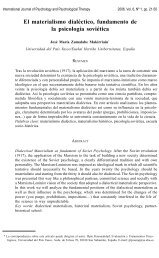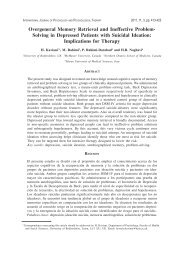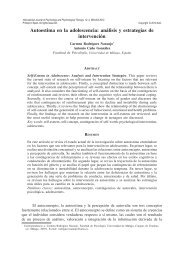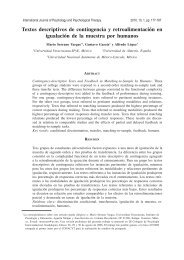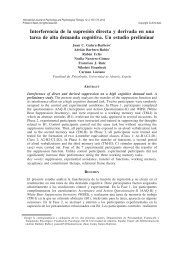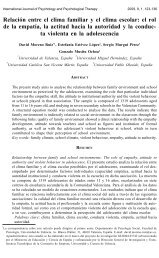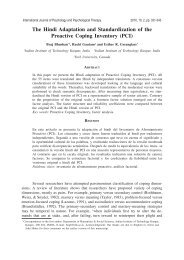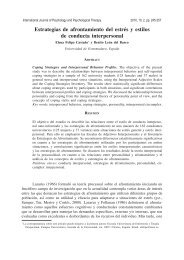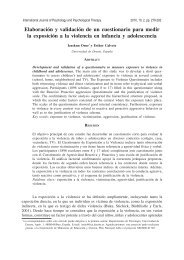The Validation of the Body Image Acceptance and Action ...
The Validation of the Body Image Acceptance and Action ...
The Validation of the Body Image Acceptance and Action ...
You also want an ePaper? Increase the reach of your titles
YUMPU automatically turns print PDFs into web optimized ePapers that Google loves.
International Journal <strong>of</strong> Psychology <strong>and</strong> Psychological <strong>The</strong>rapy 2011, 11, 3, pp. 327-345<br />
<strong>The</strong> <strong>Validation</strong> <strong>of</strong> <strong>the</strong> <strong>Body</strong> <strong>Image</strong> <strong>Acceptance</strong> <strong>and</strong><br />
<strong>Action</strong> Questionnaire: Exploring <strong>the</strong> Moderator<br />
Effect <strong>of</strong> <strong>Acceptance</strong> on Disordered Eating<br />
Cláudia Ferreira * , José Pinto-Gouveia <strong>and</strong> Cristiana Duarte<br />
University <strong>of</strong> Coimbra, Portugal<br />
Abstract<br />
<strong>The</strong> <strong>Body</strong> <strong>Image</strong>-<strong>Acceptance</strong> <strong>and</strong> <strong>Action</strong> Questionnaire measures cognitive flexibility<br />
<strong>and</strong> acceptance relatively to body image. This paper presents <strong>the</strong> factorial structure <strong>and</strong><br />
psychometric properties <strong>of</strong> <strong>the</strong> Portuguese version <strong>of</strong> <strong>the</strong> Questionnaire in a sample from<br />
<strong>the</strong> general population (n= 679). This version maintains a one-factor structure, similar<br />
to <strong>the</strong> original version <strong>of</strong> <strong>the</strong> instrument, which accounts for 63.36% <strong>of</strong> <strong>the</strong> variance. It<br />
presents high internal consistency (.95), test-retest reliability, <strong>and</strong> correlates (contrastingly)<br />
with self-compassion, body image dissatisfaction, eating disorders symptomatology, social<br />
comparison, <strong>and</strong> depression, anxiety, <strong>and</strong> stress. <strong>The</strong> Questionnaire discriminates between a<br />
clinical sample with a diagnosed eating disorder (n= 46) <strong>and</strong> a comparable general population<br />
sample (n= 51). Results show that body image acceptance is a significant predictor <strong>of</strong><br />
eating pathology, <strong>and</strong> it seems able to lessen <strong>the</strong> impact <strong>of</strong> body image dissatisfaction on<br />
<strong>the</strong> engagement on pathological restrictive behaviours <strong>and</strong> thinness seeking.<br />
Key words: body image flexibility, acceptance, eating disorders, moderator effect.<br />
Resumen<br />
El <strong>Body</strong> <strong>Image</strong>-<strong>Acceptance</strong> <strong>and</strong> <strong>Action</strong> Questionnaire mide la flexibilidad cognitiva y la<br />
aceptación de la imagen corporal. Este trabajo presenta la estructura factorial y propiedades<br />
psicométricas de la versión portuguesa del cuestionario en una muestra de la población<br />
general (n= 679). Esta versión mantiene una estructura de un solo factor, similar a la<br />
versión original del instrumento, por medio del cual es posible explicar 63,36% de la varianza.<br />
Presenta una alta consistencia interna (.95), fiabilidad test-retest, y correlaciona (en<br />
contraste) con la auto-compasión, la insatisfacción con la imagen corporal, sintomatología<br />
de trastornos de la alimentación, la comparación social, y con la depresión, la ansiedad<br />
y el estrés. El cuestionario discrimina entre una muestra clínica con un diagnóstico de<br />
trastorno de la alimentación (n= 46) y una muestra comparable de población general<br />
(n= 51). Los resultados revelan que la aceptación de la imagen corporal es un factor<br />
predictivo significativo de patología alimentaria, y parece capaz de reducir el impacto<br />
de la insatisfacción con la imagen corporal en las conductas patológicas restrictivas y de<br />
búsqueda de la delgadez.<br />
Palabras clave: teoría de la selectividad sociemocional, perspectiva de futuro, envejecimiento,<br />
bienestar, Encuesta Social Europea.<br />
*<br />
Correspondence concerning this article should be addressed to: Cláudia Ferreira, CINEICC Faculdade de Psicologia e<br />
Ciências da Educação, Universidade de Coimbra, Rua do Colégio Novo, Apartado 6153, 3001-802 Coimbra, Portugal.<br />
E-mail: claudiaferreira@fpce.uc.pt.
328<br />
Ferreira, Pinto Gouveia & Duarte<br />
<strong>Body</strong> image can be defined as <strong>the</strong> individual experience <strong>of</strong> <strong>the</strong> physical self (Cash,<br />
2004). For Thompson (1996) it encompasses three dimensions: <strong>the</strong> perceptual, which is<br />
related to <strong>the</strong> perception <strong>of</strong> one’s physical appearance <strong>and</strong> that involves an estimate <strong>of</strong><br />
one’s weight, size <strong>and</strong> body shape; <strong>the</strong> subjective (cognitive, affective), that concerns<br />
aspects such as satisfaction or worry <strong>and</strong> anxiety relatively to appearance; <strong>and</strong> <strong>the</strong><br />
behavioural dimension, that refers to <strong>the</strong> avoidance <strong>of</strong> some situations <strong>of</strong> body exposure<br />
that cause anxiety <strong>and</strong> discomfort. In a broad sense, body image is an important aspect<br />
<strong>of</strong> self-conceptualization, ei<strong>the</strong>r concerning individual development, <strong>and</strong> <strong>the</strong> definition<br />
<strong>of</strong> quality <strong>of</strong> life (e.g. Cash, 2004; Fisher & Clevel<strong>and</strong>, 1958), namely for women, for<br />
whom it becomes a central self-evaluation dimension (Ferreira, Pinto Gouveia, & Duarte,<br />
2011). Research shows that <strong>the</strong> perceived discrepancy between one’s evaluated actual<br />
body image <strong>and</strong> an image seen as an ideal one can generate considerable levels <strong>of</strong> body<br />
image dissatisfaction. This process can precede dieting (Higgins, 1987), which, in turn,<br />
is considered one <strong>of</strong> <strong>the</strong> main precipitants to eating disorders (Stice, 2001). For such<br />
reasons, this construct has been a particular field <strong>of</strong> <strong>the</strong>oretical <strong>and</strong> empirical interest,<br />
namely in what concerns its impact as a risk factor for eating disorders.<br />
<strong>The</strong> classic cognitive-behavioural perspectives on body image <strong>and</strong> its negative<br />
impact in people’s life (e.g. eating disorders) focus <strong>the</strong>ir interventions in <strong>the</strong> analysis<br />
<strong>of</strong> <strong>the</strong> accuracy <strong>and</strong> validity <strong>of</strong> <strong>the</strong> negative evaluations about one’s body, <strong>and</strong> <strong>the</strong><br />
irrational beliefs about <strong>the</strong> importance <strong>and</strong> meaning <strong>of</strong> physical appearance, changing<br />
<strong>the</strong>m to include more positive or accurate thoughts <strong>and</strong> emotions, promoting an adaptive<br />
behaviour change (Cash, 1997; Rosen, 1997). However, <strong>the</strong>ir less satisfactory outcomes,<br />
on one h<strong>and</strong>, <strong>and</strong> <strong>the</strong> fact that <strong>the</strong> investment in body image is an important relapse<br />
factor in eating disorders (Fairburn, Jones, Peveler, Hope, & O’Connor, 1993; McFarlane,<br />
Olmsted, & Trottier, 2008), on <strong>the</strong> o<strong>the</strong>r h<strong>and</strong>, contributed for <strong>the</strong> development <strong>of</strong> new<br />
perspectives where <strong>the</strong> emphasis shifts from <strong>the</strong> validity <strong>of</strong> certain thoughts or beliefs,<br />
to <strong>the</strong> inflexibility with which such cognitions are held (e.g. Hayes, 2004).<br />
<strong>Acceptance</strong> <strong>and</strong> Commitment <strong>The</strong>rapy (ACT; Hayes, Strosahl, & Wilson, 1999)<br />
is a new psycho<strong>the</strong>rapeutic modality, scientifically supported (Ruiz, 2010), based on<br />
<strong>the</strong> central conception that it is not <strong>the</strong> content <strong>of</strong> <strong>the</strong> beliefs that is problematic <strong>and</strong><br />
generates suffering, but <strong>the</strong> rigid <strong>and</strong> inflexible adherence to one’s cognitions <strong>and</strong> <strong>the</strong><br />
struggle to control or eliminate negative thoughts, referred to as experiential avoidance.<br />
According to Hayes, Wilson, Gifford, Follette <strong>and</strong> Strosahl (1996, p. 1154), “experiential<br />
avoidance is <strong>the</strong> phenomenon that occurs when a person is unwilling to remain in<br />
contact with particular private experience (e.g. bodily sensations, emotions, thoughts,<br />
memories, behavioural predispositions) <strong>and</strong> take steps to alter <strong>the</strong> form or frequency<br />
<strong>of</strong> <strong>the</strong>se experiences or <strong>the</strong> contexts that occasion <strong>the</strong>m”. <strong>The</strong> immediate effects <strong>of</strong><br />
experiential avoidance are apparently positive by reducing <strong>the</strong> avoided event (e.g.<br />
through cognitive distraction; Hayes et al., 2004). However, <strong>the</strong> attempt or efforts to<br />
suppress or eliminate negative thoughts, emotions or bodily sensations lead, many times,<br />
to <strong>the</strong> increase <strong>of</strong> <strong>the</strong>ir frequency <strong>and</strong> intensity <strong>and</strong> to <strong>the</strong> adoption <strong>of</strong> behaviours that<br />
regulate such experiences, which can become highly resistant to adaptive behavioural<br />
change (Gross, 2002). Thus, experiential avoidance has been pointed as one <strong>of</strong> <strong>the</strong><br />
major sources <strong>of</strong> human suffering. In fact, <strong>the</strong>re is been a rising number <strong>of</strong> studies that<br />
© International Journal <strong>of</strong> Psychology & Psychological <strong>The</strong>rapy, 2011, 11, 3 http://www. ijpsy. com
<strong>Body</strong> <strong>Image</strong> <strong>Acceptance</strong> <strong>and</strong> <strong>Action</strong> Questionnaire 329<br />
enlighten this process contribute to psychopathology (e.g. Hayes et al., 1999). In fact,<br />
in clinical <strong>and</strong> non-clinical samples, experiential avoidance is highly correlated with<br />
general psychopathology measures (Hayes et al., 2004) <strong>and</strong> with specific measures <strong>of</strong><br />
anxiety <strong>and</strong> depression (e.g. Marx & Sloan, 2005; Roemer, Salters, Raffa, & Orsillo,<br />
2005; Ruiz, 2010; Tull, Gratz, Salters, & Roemer, 2004).<br />
Contrary to experiential avoidance is <strong>the</strong> adaptive attitude <strong>of</strong> psychological<br />
acceptance, which comprises <strong>the</strong> ability <strong>of</strong> keeping in touch, aware <strong>and</strong> nonjudgmentally,<br />
with private events (e.g. thoughts, feelings or bodily experiences), without undertaking<br />
efforts to manipulate or follow <strong>the</strong>m, or escape or avoid <strong>the</strong>m, responding to <strong>the</strong> actual<br />
experienced events as <strong>the</strong>y occur (Hayes, Luoma, Bond, Masuda, & Lillis, 2006; Hayes<br />
et al., 2004; Hayes et al., 1996). In sum, ACT, a contextual <strong>and</strong> functional <strong>the</strong>rapy, is<br />
based in acceptance <strong>and</strong> in mindfulness strategies, <strong>and</strong> its aim is, <strong>the</strong>refore, to promote<br />
psychological flexibility, defined as <strong>the</strong> ability to contact with <strong>the</strong> present moment<br />
<strong>and</strong> be willing to change or persist with functional behavioural classes, in accordance<br />
to chosen values (Hayes, 2004; Páez Blarrina, Gutiérrez Martínez, Valdivia Salas, &<br />
Luciano, 2006).<br />
Most <strong>of</strong> <strong>the</strong> patients suffering with disordered eating <strong>and</strong> o<strong>the</strong>r related disturbances<br />
(e.g. intense body image dissatisfaction) present high levels <strong>of</strong> experiential avoidance.<br />
<strong>The</strong>y <strong>of</strong>ten describe <strong>the</strong>ir internal experience (e.g. thoughts, feelings, bodily sensations,<br />
urges, or memories) as intolerable <strong>and</strong> adopt actions to avoid or lessen its frequency<br />
<strong>and</strong> intensity (S<strong>and</strong>oz, Wilson, & DuFrene, 2010). Applied specifically to body image<br />
disturbance, ACT addresses <strong>the</strong> psychological inflexibility related to physical appearance,<br />
which comprises <strong>the</strong> rigid cognitive patterns (i.e. control) <strong>and</strong> <strong>the</strong> rigid behavioural<br />
patterns (i.e. avoidance) that seem to generate greater psychological distress <strong>and</strong> be more<br />
disruptive to life. From this point <strong>of</strong> view, <strong>the</strong> invalidation is reduced not by trying<br />
to change or eliminate negative thoughts <strong>and</strong> feelings about one’s body, but through<br />
<strong>the</strong> construction <strong>of</strong> greater flexibility, increasing body image acceptance. That refers<br />
to <strong>the</strong> ability to accept or to be willing to experience perceptions, sensations, feelings,<br />
thoughts <strong>and</strong> beliefs about one’s body, in a total <strong>and</strong> intentional way, without attempts<br />
to change <strong>the</strong>ir intensity, frequency or form, while pursuing effective actions in o<strong>the</strong>r<br />
life domains (S<strong>and</strong>oz, et al., 2009).<br />
According to this perspective, <strong>the</strong> body image (in)flexibility cannot be assessed<br />
by <strong>the</strong> existent classical measures for body image disturbance, need to control or body<br />
image avoidance, since those have been focusing on <strong>the</strong> formal properties <strong>of</strong> cognition<br />
or behaviour. For ACT, such processes need to be functionally assessed <strong>and</strong> defined,<br />
because <strong>the</strong>y are not characterized by <strong>the</strong> content <strong>of</strong> thoughts (e.g. “what I look like is an<br />
important part <strong>of</strong> who I am”; Cash, Melnyk, & Hrabosky, 2004) or by one’s behaviours<br />
(e.g. “I wear baggy clo<strong>the</strong>s”; Rosen, Srebnik, Saltzberg, & Wendt, 1991), but through<br />
<strong>the</strong> way body image has an impact in one’s life (e.g. “When I start thinking about<br />
<strong>the</strong> size <strong>and</strong> shape <strong>of</strong> my body, it becomes hard to do anything” or “Before planning<br />
something important, I need to feel better about my body”; S<strong>and</strong>oz & Wilson, 2006).<br />
To assess general psychological flexibility Hayes <strong>and</strong> colleagues (2004) developed<br />
a new measure that encompasses experiential avoidance <strong>and</strong> acceptance, <strong>the</strong> <strong>Acceptance</strong><br />
<strong>and</strong> <strong>Action</strong> Questionnaire, which has been widely used in <strong>the</strong>ir various versions (e.g.<br />
http://www. ijpsy. com © International Journal <strong>of</strong> Psychology & Psychological <strong>The</strong>rapy, 2011, 11, 3
330<br />
Ferreira, Pinto Gouveia & Duarte<br />
Hayes et al., 2004). However, researchers have been pointing out <strong>the</strong> importance <strong>of</strong><br />
using modified versions <strong>of</strong> <strong>the</strong> AAQ to target specific areas, when such instrument is<br />
used as a measure <strong>of</strong> processes <strong>of</strong> change (e.g. AAQW; Lillis & Hayes, 2008). Thus,<br />
<strong>the</strong> <strong>Body</strong> <strong>Image</strong>–<strong>Acceptance</strong> <strong>and</strong> <strong>Action</strong> Questionnaire was developed by S<strong>and</strong>oz et<br />
al. (2009) with <strong>the</strong> aim <strong>of</strong> measuring cognitive flexibility in this specific domain. <strong>The</strong><br />
development <strong>of</strong> such measure seems to be a particularly important contribution for <strong>the</strong><br />
research <strong>of</strong> how certain mechanisms, such as body image acceptance, promote changes<br />
or prevent disruptive behaviours, such as disordered eating.<br />
<strong>The</strong> present study sets out to translate <strong>and</strong> adapt to Portuguese <strong>the</strong> BI-AAQ <strong>and</strong><br />
examine its factorial structure <strong>and</strong> psychometric properties in a general population sample,<br />
with both genders <strong>and</strong> with a wide range <strong>of</strong> ages. Additionally, we aimed at exploring<br />
<strong>the</strong> moderator effect <strong>of</strong> body image acceptance on <strong>the</strong> relationship between body image<br />
dissatisfaction <strong>and</strong> disordered eating. That is, we tested if <strong>the</strong> ability to stay in touch<br />
with <strong>the</strong> ongoing private inner experience related to body image, not trying to avoid<br />
or alter it, influences <strong>the</strong> empirically acknowledge effect <strong>of</strong> feeling dissatisfied with<br />
one’s body on <strong>the</strong> endorsement <strong>of</strong> <strong>the</strong> importance <strong>of</strong> thinness (worrying about loosing<br />
weight <strong>and</strong> fear <strong>of</strong> gaining it) <strong>and</strong> consequent disruptive behaviours (e.g. dieting <strong>and</strong><br />
excessive caloric restriction).<br />
Participants<br />
Method<br />
Participants in this study were 679 subjects from general population, with 110<br />
(16.2%) males, <strong>and</strong> 569 (83.8%) females. <strong>The</strong>y present ages ranging from 13 to 50.<br />
<strong>The</strong> mean age is 19.5 (SD= 5.56). <strong>The</strong> years <strong>of</strong> education varies between 6 <strong>and</strong> 22;<br />
<strong>the</strong> mean is 12.14 (SD= 2.6). 75.2% <strong>of</strong> <strong>the</strong> sample have a calculated <strong>Body</strong> Mass Index<br />
(BMI; from self-reported weight <strong>and</strong> height) within normal range (18.5 kg/m 2 < BMI<br />
< 25 kg/m 2 ), with 12.7% classified as “underweight”, 10.1% classified as “overweight”<br />
<strong>and</strong> 0.8% classified as “obese” (WHO, 1995).<br />
Additionally, to study <strong>the</strong> scale ability to discriminate between a normal <strong>and</strong> a<br />
clinical sample, we used a convenience sample <strong>of</strong> 46 patients with <strong>the</strong> confirmed diagnosis<br />
<strong>of</strong> an eating disorder. <strong>The</strong>y present a mean age <strong>of</strong> 24.7 (SD= 8.03) <strong>and</strong> a mean <strong>of</strong> 11.98<br />
(SD= 2.96) years <strong>of</strong> education. In this sample, 35.6% <strong>of</strong> <strong>the</strong> patients have a calculated<br />
BMI equal or inferior to 17.5; 26.1 % a BMI within normal range; 8.7% are classified<br />
as “overweight” <strong>and</strong> 17.4% are classified as “obese”. In what concerns <strong>the</strong>ir diagnosis,<br />
35.6% present <strong>the</strong> diagnosis <strong>of</strong> Anorexia Nervosa, 37.8% Bulimia Nervosa, <strong>and</strong> 26.6%<br />
EDNOS (DSM-IV-TR; American Psychiatric Association, 2000). A second convenience<br />
sample <strong>of</strong> <strong>the</strong> general population (n= 51) with demographic characteristics that were<br />
comparable to <strong>the</strong> clinical sample was selected from <strong>the</strong> original sample. <strong>The</strong>y present<br />
a mean age <strong>of</strong> 24.08 (SD= 8.06), with a mean <strong>of</strong> 12.29 (SD= 3.41) years <strong>of</strong> education.<br />
<strong>The</strong> two samples do not significantly differ in what concern <strong>the</strong> demographic variables<br />
<strong>of</strong> age (t (95)<br />
=.377; p= .707) <strong>and</strong> years <strong>of</strong> education (t (95)<br />
=.484; p= .629); <strong>and</strong> <strong>the</strong> BMI<br />
mean values (t (95)<br />
=.856; p= .394).<br />
© International Journal <strong>of</strong> Psychology & Psychological <strong>The</strong>rapy, 2011, 11, 3 http://www. ijpsy. com
<strong>Body</strong> <strong>Image</strong> <strong>Acceptance</strong> <strong>and</strong> <strong>Action</strong> Questionnaire 331<br />
Measures<br />
<strong>Body</strong> <strong>Image</strong>-<strong>Acceptance</strong> <strong>and</strong> <strong>Action</strong> Questionnaire (BI-AAQ; S<strong>and</strong>oz et al., 2009). This scale<br />
was designed to measure body image acceptance, “<strong>the</strong> extent to which an individual<br />
actively contacts perceptions, thoughts, beliefs, <strong>and</strong> feelings about his or her body<br />
without directly attempting to change <strong>the</strong>ir intensity, frequency or form” (S<strong>and</strong>oz et<br />
al., 2009, p. 8). <strong>The</strong> original BI-AAQ item pool included 46 items adapted from three<br />
versions <strong>of</strong> <strong>the</strong> <strong>Acceptance</strong> <strong>and</strong> <strong>Action</strong> Questionnaire (Bond & Bunce, 2003; Bond et<br />
al., in press; Hayes et al., 2004). S<strong>and</strong>oz <strong>and</strong> colleagues (2009) rewrote <strong>the</strong> items in<br />
order to adapt <strong>the</strong>m to body-related contents, specifically on body image issues related to<br />
weight <strong>and</strong> shape, as opposed to psychological experiences in general. <strong>The</strong> participants<br />
are asked to rate <strong>the</strong> truth <strong>of</strong> each statement as it applies to <strong>the</strong>m. Items are rated in<br />
a 7-point Likert scale from 1 (“Never true”) to 7 (“Always true”).<br />
<strong>The</strong> factorial analysis <strong>of</strong> <strong>the</strong> original BI-AAQ revealed two factors, in which 29 items<br />
loaded on one factor, <strong>and</strong> 17 items loaded on both factors. Since all <strong>the</strong> items loading<br />
on <strong>the</strong> second factor were worded in <strong>the</strong> direction <strong>of</strong> “lack <strong>of</strong> acceptance” <strong>and</strong> such<br />
loading could derive from wording issues, <strong>the</strong> analysis were repeated <strong>and</strong> a single<br />
factor extracted that accounted for 34.4% <strong>of</strong> <strong>the</strong> variance. Were retained 26 items that<br />
loaded above .40, <strong>and</strong> finally, in order to produce a briefer measure, <strong>the</strong> authors retained<br />
12 items with factor loadings above .65. <strong>The</strong> BI-AAQ was shown to be internally<br />
consistent (α= .93), demonstrated good concurrent validity assessed by <strong>the</strong> correlations<br />
with general measures <strong>of</strong> mindfulness <strong>and</strong> acceptance <strong>and</strong> self-report instruments <strong>of</strong><br />
body shape concerns <strong>and</strong> disordered eating behaviours, <strong>and</strong> good criterion-related<br />
validity, with participants identified as having disordered eating tendencies exhibiting<br />
significantly lower BI-AAQ scores than <strong>the</strong> remainder <strong>of</strong> <strong>the</strong> sample (S<strong>and</strong>oz et al.,<br />
2009).<br />
For <strong>the</strong> Portuguese version <strong>and</strong> adaptation <strong>of</strong> <strong>the</strong> BI-AAQ a bilingual translator translated<br />
it into Portuguese. Fur<strong>the</strong>rmore, <strong>the</strong> research group adapted some ambiguous items<br />
to native Portuguese <strong>and</strong> <strong>the</strong> comparability <strong>of</strong> content was verified through stringent<br />
back-translation procedures.<br />
Self-Compassion Scale (SCS; Neff, 2003; Portuguese version <strong>of</strong> Castilho & Pinto-Gouveia,<br />
2011). This is a 26-item self-report measure consisting <strong>of</strong> six subscales: Self-Kindness<br />
(extending kindness <strong>and</strong> underst<strong>and</strong>ing to one’s self); Common Humanity (<strong>the</strong> ability<br />
to see one’s experience as part <strong>of</strong> <strong>the</strong> larger human condition); Mindfulness (<strong>the</strong> ability<br />
to remain aware <strong>of</strong> one’s painful experiences without becoming absorbed in <strong>the</strong>m);<br />
Self-judgment (being harshly judgmental <strong>and</strong> critical <strong>of</strong> one’s self); Isolation (seeing<br />
one’s self as separate <strong>and</strong> isolated from o<strong>the</strong>rs); <strong>and</strong> Overidentification (<strong>the</strong> tendency to<br />
overidentify with painful experiences). Items are rated on a 5-point Likert scale ranging<br />
from 1 (almost never) to 5 (almost always). In this study we used <strong>the</strong> subscales Self-<br />
Kindness, Common Humanity, <strong>and</strong> Mindfulness, in which higher scores reflect greater<br />
self-compassion. <strong>The</strong> Portuguese version <strong>of</strong> <strong>the</strong> scale (Castilho & Pinto-Gouveia, 2011)<br />
shows good internal consistency: .84 for Self-Kindness (.78 in <strong>the</strong> original version),<br />
.77 for Common Humanity (.80 in <strong>the</strong> original version), <strong>and</strong> .73 for Mindfulness (.75<br />
in <strong>the</strong> original version). In this study, <strong>the</strong> Cronbach’s alpha values were respectively<br />
<strong>of</strong> .85, .79, <strong>and</strong> .75.<br />
Figure Rating Scale (FRS; Fallon & Rozin, 1985; Thompson & Altabe, 1991; translated<br />
<strong>and</strong> adapted to Portuguese by Ferreira, 2003) is a measure <strong>of</strong> body image disturbance<br />
composed by a series <strong>of</strong> nine schematic figures <strong>of</strong> varying size, ranging from thinner<br />
silhouettes to increasingly larger silhouettes, in proportion to <strong>the</strong> number (1-9). <strong>The</strong><br />
http://www. ijpsy. com © International Journal <strong>of</strong> Psychology & Psychological <strong>The</strong>rapy, 2011, 11, 3
332<br />
Ferreira, Pinto Gouveia & Duarte<br />
respondents are asked to select <strong>the</strong> image that best indicates <strong>the</strong>ir current body image<br />
<strong>and</strong> size, <strong>and</strong> <strong>the</strong>ir ideal body image <strong>and</strong> size. <strong>The</strong> discrepancy between <strong>the</strong> actual<br />
<strong>and</strong> <strong>the</strong> ideal body image gives a measure <strong>of</strong> body image dissatisfaction. This scale<br />
shows good test-retest reliability <strong>and</strong> convergent <strong>and</strong> divergent validity (Thompson &<br />
Altabe, 1991).<br />
Eating Disorder Inventory (EDI; Garner, Olmsted, & Polivy, 1983; Portuguese version <strong>of</strong><br />
Machado, Gonçalves, Martins, & Soares, 2001). EDI corresponds to a self-evaluation<br />
comprehensive methodology <strong>of</strong> <strong>the</strong> behavioural <strong>and</strong> psychological traits in eating<br />
disorders. It is one <strong>of</strong> <strong>the</strong> most used scales for this purpose <strong>and</strong> can be used as a<br />
diagnostic measure. It is a 64-item self-report questionnaire that comprises 8 subscales<br />
assessing weight, shape <strong>and</strong> eating related attitudes <strong>and</strong> behaviours, <strong>and</strong> psychological<br />
characteristics common in patients with eating disorders. Using a 6-point Likert scale<br />
(ranging from “Always” to “Never”) respondents rate how much <strong>the</strong> item applied<br />
to <strong>the</strong>m. <strong>The</strong> most extreme eating disorder answer is scored as 3, <strong>the</strong> intermediate<br />
response as 2, <strong>the</strong> next as 1; <strong>and</strong> <strong>the</strong> o<strong>the</strong>r remain 3 responses receive no score. Several<br />
studies have established <strong>the</strong> reliability <strong>and</strong> validity <strong>of</strong> <strong>the</strong> EDI (see, Garner (1990) for<br />
a review). In <strong>the</strong> current study, we focused on <strong>the</strong> Drive for Thinness, Bulimia, <strong>and</strong><br />
<strong>Body</strong> Dissatisfaction subscales because <strong>the</strong>y are most clearly linked to eating disorders<br />
symptoms. <strong>The</strong> Portuguese version presents good to very good internal consistency for<br />
<strong>the</strong> three subscales (.91; .81; .91, respectively, Machado et al., 2001). <strong>The</strong> Cronbach’s<br />
alphas for this sample were .83, .77, <strong>and</strong> .89, respectively.<br />
Depression, Anxiety <strong>and</strong> Stress Scales (DASS42; Lovibond & Lovibond, 1995; Portuguese<br />
version <strong>of</strong> Pais-Ribeiro, Honrado, & Leal, 2004). This scale includes three subscales<br />
(<strong>of</strong> 14 items each) designed to measure levels <strong>of</strong> Depression, Anxiety, <strong>and</strong> Stress. <strong>The</strong><br />
point is to obtain an estimate <strong>of</strong> how much <strong>the</strong> subjects experienced each symptom<br />
during <strong>the</strong> previous week in a 4-point scale. Higher results indicate higher levels <strong>of</strong><br />
emotional distress. <strong>The</strong> Cronbach’s alpha <strong>of</strong> <strong>the</strong> Portuguese version (Pais Ribeiro et al.,<br />
2004) resembles <strong>the</strong> original ones: .93 for Depression (.91 in <strong>the</strong> original version), .83<br />
for Anxiety subscale (.84 in <strong>the</strong> original version), <strong>and</strong> finally .88 for Stress subscale<br />
(.90 in <strong>the</strong> original version). In <strong>the</strong> present study <strong>the</strong> Cronbach’s alpha values were<br />
<strong>of</strong> .96, .93 <strong>and</strong> .94, respectively.<br />
Social Comparison through Physical Appearance Scale (SCPAS; Ferreira et al., 2011).<br />
SCPAS is a 12-item self-report measure that assesses <strong>the</strong> respondents’ perceptions <strong>of</strong><br />
self-ranking when <strong>the</strong>y compare physically with o<strong>the</strong>rs. It has two parts: in <strong>the</strong> first one<br />
<strong>the</strong> evaluation is done concerning friends, colleagues or o<strong>the</strong>r known girls; whilst <strong>the</strong><br />
second concerns models, actresses or o<strong>the</strong>r celebrities. It uses a semantic differential<br />
methodology according to which <strong>the</strong> subject is asked to rate himself on a 10-point<br />
scale with each item ranging between two opposed descriptors (e.g. “Inferior-Superior,<br />
Undesirable-More Desirable). Originally this scale showed good temporal stability,<br />
convergent <strong>and</strong> discriminant validity, <strong>and</strong> internal reliability coefficients <strong>of</strong> .94 for<br />
<strong>the</strong> Peers subscale <strong>and</strong> <strong>of</strong> .96 for <strong>the</strong> Models subscale (Ferreira et al., 2011). In this<br />
study <strong>the</strong> Cronbach’s alpha obtained were also high (.94 <strong>and</strong> .96 for <strong>the</strong> subscales<br />
Peers <strong>and</strong> Models, respectively).<br />
Eating Disorder Examination 16.0D (EDE 16.0D; Fairburn, Cooper, & O’Connor, 2008;<br />
translated <strong>and</strong> adapted to Portuguese by Ferreira, Pinto-Gouveia & Duarte, 2010). EDE<br />
16.0D is a st<strong>and</strong>ardized interview that can be used for diagnosing eating disorders, <strong>and</strong><br />
allows <strong>the</strong> assessment <strong>of</strong> <strong>the</strong> frequency <strong>and</strong> intensity <strong>of</strong> behavioural <strong>and</strong> psychological<br />
aspects <strong>of</strong> eating disorders, such as restriction habits, eating concerns, <strong>and</strong> weight<br />
<strong>and</strong> shape concerns. It is considered a precise evaluation method with high values <strong>of</strong><br />
© International Journal <strong>of</strong> Psychology & Psychological <strong>The</strong>rapy, 2011, 11, 3 http://www. ijpsy. com
<strong>Body</strong> <strong>Image</strong> <strong>Acceptance</strong> <strong>and</strong> <strong>Action</strong> Questionnaire 333<br />
internal consistency, <strong>of</strong> test-retest reliability <strong>and</strong> discriminant <strong>and</strong> concurrent validity<br />
(for a review see Fairburn, 2008).<br />
<strong>Body</strong> Mass Index. We calculated participant’s BMI dividing weight (in kg) by height<br />
squared (in m) (i.e., Wt/Ht2).<br />
Procedure<br />
<strong>The</strong> participants were students recruited from middle <strong>and</strong> high schools, <strong>and</strong><br />
also from <strong>the</strong> University <strong>of</strong> Coimbra, Portugal; <strong>and</strong> subjects with diverse pr<strong>of</strong>essions<br />
recruited in different public institutions <strong>and</strong> private corporations (e.g. pr<strong>of</strong>essors, school<br />
<strong>and</strong> hospital staff). <strong>The</strong> involved institutions’ boards were contacted, <strong>the</strong> research aims<br />
were clarified <strong>and</strong> authorization was obtained so that <strong>the</strong> subjects could voluntarily<br />
participate. <strong>The</strong> clinical sample was recruited in <strong>the</strong> University <strong>of</strong> Coimbra Hospitals,<br />
Portugal, with <strong>the</strong> previous consent <strong>of</strong> <strong>the</strong> respective Ethics Committee, <strong>and</strong> in private<br />
clinics. <strong>The</strong> diagnoses were established by EDE 16.0 (Fairburn et al., 2008), which<br />
was administered by experienced <strong>the</strong>rapists <strong>and</strong> researchers with previous training <strong>and</strong><br />
supervision. Patients in denial <strong>of</strong> <strong>the</strong>ir clinical condition were excluded because <strong>of</strong><br />
possible answer bias.<br />
All participants were given a battery <strong>of</strong> self-report questionnaires that assess<br />
psychological flexibility, body image dissatisfaction, disordered eating, social adjustment<br />
<strong>and</strong> general psychological difficulties. <strong>The</strong>y received previous clarification about <strong>the</strong><br />
procedures, <strong>the</strong> study’s general goals, <strong>and</strong> that <strong>the</strong>ir answers were confidential <strong>and</strong> gave<br />
<strong>the</strong>ir informed consent to participate in <strong>the</strong> study.<br />
To examine <strong>the</strong> retest reliability, 62 participants were r<strong>and</strong>omly selected from<br />
<strong>the</strong> original sample to complete <strong>the</strong> retest version <strong>of</strong> <strong>the</strong> BI-AAQ after a three to four<br />
week interval.<br />
Analytic Strategy<br />
We used <strong>the</strong> Version 18.0 <strong>of</strong> <strong>the</strong> SPSS (Statistical Package for <strong>the</strong> Social Sciences)<br />
to analyse <strong>the</strong> factorial structure <strong>of</strong> <strong>the</strong> BI-AAQ <strong>and</strong> to perform descriptive <strong>and</strong> inferential<br />
analyses. <strong>The</strong> s<strong>of</strong>tware AMOS (v.18, SPSS Inc. Chicago, IL) was fur<strong>the</strong>r used to assess<br />
<strong>the</strong> confirmatory factorial structure <strong>of</strong> <strong>the</strong> BI-AAQ.<br />
For <strong>the</strong> study <strong>of</strong> <strong>the</strong> dimensional structure <strong>of</strong> <strong>the</strong> Portuguese version <strong>of</strong> <strong>the</strong><br />
questionnaire we used <strong>the</strong> same procedure as <strong>the</strong> authors <strong>of</strong> <strong>the</strong> original <strong>Body</strong> <strong>Image</strong><br />
-<strong>Acceptance</strong> <strong>and</strong> <strong>Action</strong> Questionnaire (S<strong>and</strong>oz et al., 2009), proceeding to a Principal<br />
Component Analysis. A Confirmatory Factor Analysis was fur<strong>the</strong>r conducted to confirm<br />
<strong>the</strong> structure <strong>of</strong> BI-AAQ. <strong>The</strong> internal reliability <strong>of</strong> <strong>the</strong> scale was examined through<br />
<strong>the</strong> Cronbach’s alpha coefficient <strong>and</strong> item-total correlation. Concurrent <strong>and</strong> divergent<br />
validity <strong>of</strong> <strong>the</strong> BI-AAQ was assessed by computing Pearson product-moment correlation<br />
coefficients. Retest reliability was analysed by t-Tests for Dependent Samples comparing<br />
<strong>the</strong> first <strong>and</strong> second administration mean values <strong>of</strong> <strong>the</strong> scale, <strong>and</strong> by Pearson productmoment<br />
correlations. <strong>The</strong> results for each <strong>of</strong> <strong>the</strong> clinical <strong>and</strong> non-clinical samples were<br />
compared using t-Tests for Two Independent Samples.<br />
http://www. ijpsy. com © International Journal <strong>of</strong> Psychology & Psychological <strong>The</strong>rapy, 2011, 11, 3
334<br />
Ferreira, Pinto Gouveia & Duarte<br />
Finally, in <strong>the</strong> moderator analysis multiple hierarchical regression analyses were<br />
used to test <strong>the</strong> effects <strong>of</strong> <strong>the</strong> moderator (body image acceptance, as measured by <strong>the</strong><br />
BI-AAQ) on <strong>the</strong> relationship between <strong>the</strong> independent (body image dissatisfaction, as<br />
measured by <strong>the</strong> FRS) <strong>and</strong> <strong>the</strong> dependent variable (drive for thinness, as measured by<br />
EDI).<br />
Results<br />
In <strong>the</strong> Principal Component Analysis we began by confirming <strong>the</strong> suitability <strong>of</strong><br />
<strong>the</strong> data for posterior analysis using <strong>the</strong> Kaiser Meyer-Olkin test (.954) <strong>and</strong> <strong>the</strong> Bartlett’s<br />
sphericity test (χ 2 (66)=6195.989; p= .000). We used Kaiser-Guttman criteria, <strong>and</strong> also <strong>the</strong><br />
Catell’s scree test, that indicated <strong>the</strong> decision <strong>of</strong> retaining a single factor, as <strong>the</strong>oretically<br />
expected (S<strong>and</strong>oz et al., 2009). Every item presented communalities values superior to<br />
.3. All items present high factor loadings, varying from .554 (Item 6: “If I start to feel<br />
fat, I try to think about something else”) to .854 (Item 9: “To control my life, I need<br />
to control my weight”) (see Table 1). <strong>The</strong> one-dimensional structure explains a total <strong>of</strong><br />
63.36% <strong>of</strong> <strong>the</strong> variance.<br />
To confirm <strong>the</strong> previous proposed BI-AAQ one-factor structure we conducted a<br />
CFA, which assesses <strong>the</strong> discrepancy between <strong>the</strong> <strong>the</strong>oretical proposed model <strong>and</strong> our<br />
data. This procedure was conducted using <strong>the</strong> WLSMV (Weighted least square parameter<br />
using a diagonal weight matrix with robust errors <strong>and</strong> means), since our observed<br />
variables could be considered ordinal variables in a 7-point response scale, with each<br />
latent variable representing a continuous variable.<br />
Since we used Maximum Likelihood Estimation to estimate <strong>the</strong> model parameters,<br />
it was necessary to evaluate <strong>the</strong> multivariate normality assumption. Skewness <strong>and</strong><br />
Kurtosis values did not presented a serious bias to normal distribution (SK < |3| <strong>and</strong><br />
Ku < |10|) (Kline, 1998), <strong>and</strong> although some cases presented Mahalanobis Distance<br />
(DM2) values indicating <strong>the</strong> existence <strong>of</strong> outliers, we opted to maintain <strong>the</strong>m because<br />
its removal would diminish <strong>the</strong> variability associated to <strong>the</strong> factor in study <strong>and</strong> would<br />
constrict possible interpretation that might be <strong>of</strong> interest in <strong>the</strong>se analyses.<br />
CFA uses multiple goodness-<strong>of</strong>-fit indices to confirm a factor structure, because<br />
<strong>the</strong>y have different strengths <strong>and</strong> weaknesses in assessing <strong>the</strong> goodness-<strong>of</strong>-fit between <strong>the</strong><br />
hypo<strong>the</strong>tical model <strong>and</strong> <strong>the</strong> actual model. First we used <strong>the</strong> chi-square goodness-<strong>of</strong>-fit,<br />
which measures <strong>the</strong> discrepancy between <strong>the</strong> predicted model <strong>and</strong> <strong>the</strong> data. Thus, nonsignificant<br />
results indicate that <strong>the</strong> data are consistent with <strong>the</strong> model <strong>and</strong> significance in<br />
this test indicates that <strong>the</strong> data are inconsistent with <strong>the</strong> model. However, this index is<br />
very sensitive to sample size. <strong>The</strong>refore, as recommended, we fur<strong>the</strong>r used o<strong>the</strong>r global<br />
fit indices: Goodness-<strong>of</strong>-fit index (GFI), because it measures <strong>the</strong> amount <strong>of</strong> variance<br />
<strong>and</strong> covariance explained by <strong>the</strong> model <strong>and</strong>, contrary to <strong>the</strong> chi-square goodness-<strong>of</strong>-fit,<br />
it is not affected by <strong>the</strong> sample size. (Saris & Stronkhorst, 1984); <strong>the</strong> Comparative Fit<br />
index (CFI) which quantifies <strong>the</strong> relative improvement in fit <strong>of</strong> <strong>the</strong> hypo<strong>the</strong>sized model<br />
over that <strong>of</strong> a null model according to which all indicators are uncorrelated; <strong>and</strong> <strong>the</strong><br />
Tucker <strong>and</strong> Lewis Index (TLI) that should be interpreted as <strong>the</strong> CFI. <strong>The</strong>se indexes<br />
© International Journal <strong>of</strong> Psychology & Psychological <strong>The</strong>rapy, 2011, 11, 3 http://www. ijpsy. com
<strong>Body</strong> <strong>Image</strong> <strong>Acceptance</strong> <strong>and</strong> <strong>Action</strong> Questionnaire 335<br />
Table 1. Factor analysis, factorial loadings, means, st<strong>and</strong>ard deviations, <strong>and</strong> reliability<br />
Factor<br />
Analysis<br />
Factorial<br />
loadings M SD<br />
Corrected<br />
Item-total<br />
correlation<br />
α if item<br />
deleted<br />
Items 1 h 2 STR SMC<br />
9. To control my life, I need to control my weight. .854 .730 .840 .706 5.35 1.76 .817 .938<br />
10. Feeling fat causes problems in my life. .848 .720 .836 .698 5.23 1.90 .811 .938<br />
3. I shut down when I feel bad about my body shape or<br />
weight.<br />
.848 .719 .836 .699 4.89 1.72 .808 .938<br />
11. When I start thinking about <strong>the</strong> size <strong>and</strong> shape <strong>of</strong> my<br />
body, it’s hard to do anything else.<br />
.839 .704 .827 .684 5.61 1.62 .798 .939<br />
1. Worrying about my weight makes it difficult for me to live<br />
a life that I value.<br />
.834 .696 .824 .679 5.35 1.67 .790 .939<br />
4. My thoughts <strong>and</strong> feelings about my body weight <strong>and</strong> shape<br />
must change before I can take important steps in my life.<br />
.828 .686 .809 .655 5.36 1.65 .785 .939<br />
5. Worrying about my body takes up too much <strong>of</strong> my time. .820 .673 .803 .645 5.54 1.53 .775 .940<br />
2. I care too much about my weight <strong>and</strong> body shape. .804 .647 .789 .623 4.58 1.77 .757 .940<br />
12. My relationships would be better if my body weight<br />
<strong>and</strong>/or shape did not bo<strong>the</strong>r me.<br />
.797 .635 .777 .603 5.37 1.83 .748 .940<br />
7. Before I can make any serious plans, I have to feel better<br />
about my body.<br />
.775 .601 .735 .540 5.10 1.68 .736 .941<br />
8. I will have better control over my life if I can control my<br />
.698 .488 .654 .427 4.66 1.89 .649 .944<br />
negative thoughts about my body.<br />
6. If I start to feel fat, I try to think about something else. .554 .307 .507 .258 5.13 1.74 .503 .948<br />
Eigenvalue 7.604<br />
h 2 : communalities values.<br />
STR: St<strong>and</strong>ardized Regression Weights.<br />
SMC: Squared Multiple Correlations.<br />
http://www. ijpsy. com © International Journal <strong>of</strong> Psychology & Psychological <strong>The</strong>rapy, 2011, 11, 3
336<br />
Ferreira, Pinto Gouveia & Duarte<br />
eit9 <br />
it9 <br />
eit10 <br />
it10 <br />
eit3 <br />
it3 <br />
eit11 <br />
it11 <br />
eit1 <br />
it1 <br />
eit4 <br />
eit5 <br />
it4 <br />
it5 <br />
BIAAQ <br />
eit2 <br />
it2 <br />
eit12 <br />
it12 <br />
eit7 <br />
it7 <br />
eit8 <br />
it8 <br />
eit6 <br />
it6 <br />
Figure 1. Graphic representation <strong>of</strong> <strong>the</strong> BI-AAQ factorial structure.<br />
vary between 0 (no fit) -1 (perfect fit) with values ≥ 0.9 indicating adequate fit (Byrne,<br />
2010). Aditionally, we used <strong>the</strong> PCFI (Parsimony Normed Comparative Fit Index), a<br />
parsimony adjusted fit measure, in which values between 0.6 <strong>and</strong> 0.8 indicate a good<br />
fit (Maroco, 2010).<br />
Figure 1 shows <strong>the</strong> graphic representation <strong>of</strong> <strong>the</strong> hypo<strong>the</strong>sized model that is to<br />
be tested to see how well it fits de observed data (12 observed variables comprising a<br />
single factor). For <strong>the</strong> one-factor model, <strong>the</strong> chi-square goodness-<strong>of</strong>-fit was significant<br />
(χ 2 = 490.652; df= 54, p
<strong>Body</strong> <strong>Image</strong> <strong>Acceptance</strong> <strong>and</strong> <strong>Action</strong> Questionnaire 337<br />
No post-hoc modifications were indicated from <strong>the</strong> analysis because <strong>the</strong> goodfit-indexes,<br />
<strong>and</strong> <strong>the</strong> residual analysis did not indicate any problems.<br />
Table 1 presents <strong>the</strong> means, st<strong>and</strong>ard deviations <strong>and</strong> <strong>the</strong> internal reliability coefficients<br />
for <strong>the</strong> Portuguese BI-AAQ. Results show a very good internal reliability with<br />
an alpha <strong>of</strong> .945. All items <strong>of</strong> <strong>the</strong> scale present item-total correlation coefficients about<br />
.8, with <strong>the</strong> exception <strong>of</strong> <strong>the</strong> items 8 <strong>and</strong> 6 with values <strong>of</strong> .649 <strong>and</strong> .503, respectively.<br />
<strong>The</strong>se results show <strong>the</strong> quality <strong>and</strong> suitability <strong>of</strong> <strong>the</strong> items for this scale. In fact, were<br />
obtained values that vary between .503 (item 6) <strong>and</strong> .817 (item 9).<br />
Analyses were conducted to examine <strong>the</strong> associations between BI-AAQ <strong>and</strong> o<strong>the</strong>r<br />
measures. First, correlational analyses were conducted to examine <strong>the</strong> relationships<br />
between body image acceptance <strong>and</strong> potential covariates. <strong>The</strong> relationship between BMI<br />
<strong>and</strong> <strong>Body</strong> <strong>Image</strong> <strong>Acceptance</strong> was significant with a low magnitude, such that higher<br />
BMI was associated with lower <strong>Body</strong> <strong>Image</strong> <strong>Acceptance</strong> (r= -.247; p= .000). Also, <strong>the</strong><br />
relationship between age <strong>and</strong> body image acceptance was positive <strong>and</strong> significant, with<br />
a very low magnitude (r= .179; p= .000). For this reason, BMI <strong>and</strong> age were controlled<br />
for in subsequent analyses.<br />
To evaluate concurrent <strong>and</strong> divergent validity <strong>of</strong> <strong>the</strong> BI-AAQ Pearson productmoment<br />
correlation coefficients were calculated between <strong>Body</strong> <strong>Image</strong> <strong>Acceptance</strong> <strong>and</strong><br />
Self-Compassion (SCS), <strong>Body</strong> <strong>Image</strong> Dissatisfaction (FRS), eating disorders symptoms<br />
-Drive for Thinness, Bulimia <strong>and</strong> <strong>Body</strong> Dissatisfaction (EDI); Social Comparison through<br />
Physical Appearance with Peers <strong>and</strong> Models (SCPAS) <strong>and</strong> Depression, Anxiety <strong>and</strong><br />
Stress symptoms (DASS42), after controlling for BMI <strong>and</strong> age.<br />
<strong>The</strong> results given in Table 2 show that <strong>the</strong> BI-AAQ positively correlates with o<strong>the</strong>r<br />
measures that comprise psychological flexibility such as self-compassion dimensions,<br />
Self-Kindness, Common Humanity <strong>and</strong> Mindfulness. BI-AAQ positively correlates to<br />
Social Comparisons with Peers <strong>and</strong> Models, using physical appearance as a reference.<br />
It negatively correlates with psychopathology measures -Depression, Anxiety <strong>and</strong> Stress.<br />
Table 2. Partial Correlations between BI-AAQ <strong>and</strong> SC, FRS,<br />
EDI, SCPAS, <strong>and</strong> DASS42, after controlling for BMI <strong>and</strong> age<br />
r<br />
SC – Self Kindness<br />
SC – Common Humanity<br />
SC - Mindfulness<br />
FRS - <strong>Body</strong> <strong>Image</strong> Dissatisfaction<br />
EDI -Drive for Thinness<br />
EDI – Bulimia<br />
EDI – <strong>Body</strong> Dissatisfaction<br />
SCPAS – Peers<br />
SCPAS - Models<br />
DASS42 - Depression<br />
DASS42 - Anxiety<br />
DASS42 - Stress<br />
.229 **<br />
.182 **<br />
.171 **<br />
-.356 **<br />
-.663 **<br />
-.293 **<br />
-.582 **<br />
.417 **<br />
.421 **<br />
-.452 **<br />
-.375 **<br />
-.386 **<br />
**<br />
p
338<br />
Ferreira, Pinto Gouveia & Duarte<br />
In what concerns <strong>the</strong> eating disorders symptomatology, <strong>the</strong> scale shows negative correlations<br />
with <strong>Body</strong> <strong>Image</strong> Dissatisfaction <strong>and</strong>, with higher magnitudes, with Drive for<br />
Thinness <strong>and</strong> <strong>Body</strong> Dissatisfaction (EDI subscales).<br />
<strong>The</strong> scale presents good test-retest reliability (r= .823; p= .000). Additionally <strong>the</strong><br />
t value was .451 (p= .654), which confirms <strong>the</strong> temporal stability <strong>of</strong> <strong>the</strong> instrument.<br />
We found statistically significant difference between genders (t= 2.149; p= .032),<br />
with males presenting higher scores in comparison to females (M= 65.25; SD= 15.38<br />
vs. M= 61.59; SD= 16.56, respectively). Such results replicate those by S<strong>and</strong>oz et al<br />
(2009) that also found statistically significant differences between genders, with males<br />
reporting higher body image acceptance than females.<br />
To study <strong>the</strong> BI-AAQ ability to discriminate eating disorders patients, we<br />
compared a convenience sample <strong>of</strong> <strong>the</strong> general population (n= 51) <strong>and</strong> a clinical sample<br />
constituted by 46 patients diagnosed with an eating disorder with similar demographic<br />
characteristics. <strong>The</strong> patients’ BI-AAQ scores mean was 31.43 (SD= 11.79), whilst <strong>the</strong><br />
general population participants’ mean was 67.39 (SD= 12.04). <strong>The</strong> t value was 14.835<br />
(p= .000) showing that <strong>the</strong>re is a statistically significant difference between <strong>the</strong> groups,<br />
with <strong>the</strong> patients with an eating disorder reporting lower body image acceptance than<br />
<strong>the</strong> normal population participants.<br />
In order to fur<strong>the</strong>r explore <strong>the</strong> importance <strong>of</strong> <strong>Body</strong> <strong>Image</strong> <strong>Acceptance</strong> for eating<br />
disorders, we conducted a series <strong>of</strong> hierarchical multiple regression analyses predicting <strong>the</strong><br />
tendency to diet <strong>and</strong> restrict eating (a central symptom in such disorders). We considered<br />
that disordered eating tendencies are distributed according to a gravity continuum<br />
between general <strong>and</strong> clinical population with eating disorders. So, in this section we<br />
opted to ga<strong>the</strong>r <strong>the</strong> nonclinical <strong>and</strong> <strong>the</strong> clinical sample toge<strong>the</strong>r (total sample N= 725).<br />
<strong>The</strong> visual inspection <strong>of</strong> <strong>the</strong> distributions showed that <strong>the</strong> total sample did not create<br />
a bimodal distribution. Fur<strong>the</strong>rmore, although <strong>the</strong> Kolmogorov-Smirnov test confirmed<br />
that <strong>the</strong> distribution was biased from normal curve, Skewness values ranged from -.74<br />
<strong>and</strong> 1.47, <strong>and</strong> Kurtosis values between -.353 <strong>and</strong> 3.46. Such values, according to Kline<br />
(1998), are acceptable <strong>and</strong> do not represent a serious bias. Additionally, we analysed <strong>the</strong><br />
suitability <strong>of</strong> <strong>the</strong> current data for regression analyses. <strong>The</strong> normal distribution, linearity<br />
<strong>and</strong> homoscedasticity <strong>of</strong> residuals were confirmed through <strong>the</strong> analysis <strong>of</strong> residuals scatter<br />
plots. Also, <strong>the</strong> independence <strong>of</strong> <strong>the</strong> errors was analysed <strong>and</strong> validated through graphic<br />
analysis <strong>and</strong> <strong>the</strong> value <strong>of</strong> Durbin-Watson (values ranged between 1.963 <strong>and</strong> 1.991). We<br />
found no evidence <strong>of</strong> multicollinearity or singularity amongst <strong>the</strong> variables. Variance<br />
Inflation Factor (VIF) values indicated <strong>the</strong> absence <strong>of</strong> β estimation problems (VIF
<strong>Body</strong> <strong>Image</strong> <strong>Acceptance</strong> <strong>and</strong> <strong>Action</strong> Questionnaire 339<br />
Table 3. Hierarchical multiple regression using BMI, <strong>Body</strong> <strong>Image</strong> Dissatisfaction (FRS) <strong>and</strong> <strong>Body</strong><br />
<strong>Image</strong> <strong>Acceptance</strong> (BI-AAQ) to predict Drive for Thinness (EDI; criterion variable; N= 725)<br />
Model Predictors β t p R R 2 F p<br />
Step 1 .187 .035 25.899 .000<br />
BMI .187 5.089 .000<br />
Step 2 .488 .238 191.624 .000<br />
BMI -.102 -2.629 .009<br />
<strong>Body</strong> <strong>Image</strong><br />
Dissatisfaction<br />
.535 13.843 .000<br />
Step 3 .751 .564 535.032 .000<br />
BMI -.092 -3.156 .002<br />
<strong>Body</strong> <strong>Image</strong><br />
.261 8.273 .000<br />
Dissatisfaction<br />
<strong>Body</strong> <strong>Image</strong><br />
<strong>Acceptance</strong><br />
-.631<br />
-<br />
23.131<br />
Given <strong>the</strong> previous findings we sought to explore <strong>the</strong> impact <strong>of</strong> <strong>Body</strong> <strong>Image</strong><br />
<strong>Acceptance</strong> on <strong>the</strong> relationship between <strong>Body</strong> <strong>Image</strong> Dissatisfaction <strong>and</strong> Drive for<br />
Thinness. In order to analyse such moderator effect <strong>of</strong> <strong>the</strong> <strong>Body</strong> <strong>Image</strong> <strong>Acceptance</strong>,<br />
we conducted a multiple hierarchical regression analysis considering <strong>the</strong> interaction <strong>of</strong><br />
a continuous predictor (Cohen, Cohen, West, & Aiken, 2003). In this procedure, in an<br />
attempt to reduce <strong>the</strong> error associated with multicollinearity, we have used a st<strong>and</strong>ardized<br />
procedure, centring <strong>the</strong> values <strong>of</strong> <strong>the</strong> two predictors (<strong>Body</strong> <strong>Image</strong> Dissatisfaction <strong>and</strong><br />
<strong>Body</strong> <strong>Image</strong> <strong>Acceptance</strong>) <strong>and</strong> <strong>the</strong>n obtained <strong>the</strong> interaction product by multiplying <strong>the</strong><br />
two created variables (Aiken & West, 1991).<br />
<strong>The</strong>refore, we verified that <strong>the</strong> three steps <strong>of</strong> <strong>the</strong> model are statistically significant<br />
(Table 4). On step one, we entered <strong>Body</strong> <strong>Image</strong> Dissatisfaction as a predictor <strong>and</strong> on<br />
step two we fur<strong>the</strong>r included <strong>Body</strong> <strong>Image</strong> <strong>Acceptance</strong> as a predictor variable. In both<br />
Table 4. Hierarchical multiple regression using <strong>Body</strong> <strong>Image</strong> Dissatisfaction (FRS) to predict Drive<br />
for Thinness (EDI) having <strong>Body</strong> <strong>Image</strong> <strong>Acceptance</strong> (BI-AAQ) as a moderator (N=725)<br />
Model Predictors β t p R R 2 F p<br />
Step 1 .480 .231 216.735 .000<br />
<strong>Body</strong> <strong>Image</strong><br />
Dissatisfaction<br />
.480 14.722 .000<br />
Step 2 .748 .559 538.223 .000<br />
<strong>Body</strong> <strong>Image</strong><br />
Dissatisfaction<br />
.211 7.717 .000<br />
<strong>Body</strong> <strong>Image</strong><br />
<strong>Acceptance</strong><br />
-.633 -23.200 .000<br />
Step 3 .762 .581 38.096 .000<br />
<strong>Body</strong> <strong>Image</strong><br />
Dissatisfaction<br />
.164 5.925 .000<br />
<strong>Body</strong> <strong>Image</strong><br />
<strong>Acceptance</strong><br />
-.616 -22.989 .000<br />
<strong>Body</strong> <strong>Image</strong><br />
Dissatisfaction x<br />
<strong>Body</strong> <strong>Image</strong><br />
<strong>Acceptance</strong><br />
-.159 -6.172 .000<br />
.000<br />
http://www. ijpsy. com © International Journal <strong>of</strong> Psychology & Psychological <strong>The</strong>rapy, 2011, 11, 3
340<br />
Ferreira, Pinto Gouveia & Duarte<br />
9<br />
BIAAQ high med low <br />
8<br />
7<br />
6<br />
Drive for Thinness <br />
5<br />
4<br />
3<br />
2<br />
1<br />
0<br />
<strong>Body</strong> <strong>Image</strong> Dissatisfaction <br />
Figure 2. Graphic for <strong>the</strong> relation between <strong>Body</strong> <strong>Image</strong> Dissatisfaction (FRS) <strong>and</strong> Drive<br />
for Thinness (EDI) with different levels <strong>of</strong> <strong>Body</strong> <strong>Image</strong> <strong>Acceptance</strong> (BI-AAQ).<br />
steps <strong>the</strong> predictors entered produced statistically significant models. <strong>The</strong> third step,<br />
where <strong>the</strong> interaction terms were entered, presents a R 2 <strong>of</strong> .581 (F (1, 721)<br />
= 38.096; p=<br />
.000). Thus, <strong>the</strong>re was a significant interaction <strong>of</strong> <strong>Body</strong> <strong>Image</strong> <strong>Acceptance</strong> <strong>and</strong> <strong>Body</strong><br />
Dissatisfaction on predicting Drive for Thinness.<br />
From <strong>the</strong> regression coefficients analysis (Table 4) we can see that both <strong>Body</strong><br />
<strong>Image</strong> Dissatisfaction <strong>and</strong> <strong>Body</strong> <strong>Image</strong> <strong>Acceptance</strong> are statically significant predictors,<br />
in all steps <strong>of</strong> model. <strong>The</strong> interaction between <strong>the</strong>se two variables points out to <strong>the</strong><br />
existence <strong>of</strong> a moderator effect <strong>of</strong> <strong>Body</strong> <strong>Image</strong> <strong>Acceptance</strong> on <strong>the</strong> relation between<br />
<strong>Body</strong> <strong>Image</strong> Dissatisfaction <strong>and</strong> Drive for Thinness (β= -.159; t (720)<br />
= -6.172; p= .000).<br />
To better underst<strong>and</strong> <strong>the</strong> relation between <strong>Body</strong> <strong>Image</strong> Dissatisfaction <strong>and</strong> Drive<br />
for Thinness with different levels <strong>of</strong> <strong>Body</strong> <strong>Image</strong> <strong>Acceptance</strong> we plotted a graphic (Figure<br />
2) considering one curve for each <strong>of</strong> <strong>the</strong> three <strong>Body</strong> <strong>Image</strong> <strong>Acceptance</strong> (BI-AAQ) levels<br />
(low, medium <strong>and</strong> high). This procedure is recommended to highlight this relation <strong>and</strong><br />
can be done with centred <strong>and</strong> uncentred variables (Aiken & West, 1991; Cohen et al.,<br />
2003). We opted for <strong>the</strong> centred variables. To proceed with this representation, <strong>and</strong> since<br />
we did not have <strong>the</strong>oretical cut points, we plotted <strong>the</strong> three curves taking into account<br />
<strong>the</strong> following cut-point values <strong>of</strong> BI-AAQ variable on <strong>the</strong> x axis: one st<strong>and</strong>ard deviation<br />
below <strong>the</strong> mean, <strong>the</strong> mean <strong>and</strong> one st<strong>and</strong>ard deviation above <strong>the</strong> mean, following Cohen<br />
<strong>and</strong> colleagues (2003) recommendation.<br />
Individuals with lower levels <strong>of</strong> <strong>Body</strong> <strong>Image</strong> <strong>Acceptance</strong> show a positive <strong>and</strong> high<br />
relation with Drive for Thinness comparing to those who have medium <strong>and</strong> high values.<br />
In <strong>the</strong>se two cases <strong>the</strong> relation is less expressive, being noteworthy that individuals who<br />
have high levels <strong>of</strong> <strong>Body</strong> <strong>Image</strong> <strong>Acceptance</strong> <strong>and</strong> high levels <strong>of</strong> <strong>Body</strong> <strong>Image</strong> Dissatisfaction<br />
only show a small to moderate relation with dieting <strong>and</strong> restrictive behaviours.<br />
© International Journal <strong>of</strong> Psychology & Psychological <strong>The</strong>rapy, 2011, 11, 3 http://www. ijpsy. com
<strong>Body</strong> <strong>Image</strong> <strong>Acceptance</strong> <strong>and</strong> <strong>Action</strong> Questionnaire 341<br />
Discussion<br />
<strong>The</strong> purpose <strong>of</strong> this study was to present <strong>and</strong> validate <strong>the</strong> Portuguese version <strong>of</strong><br />
<strong>the</strong> <strong>Body</strong> <strong>Image</strong>-<strong>Acceptance</strong> <strong>and</strong> <strong>Action</strong> Questionnaire (BI-AAQ: S<strong>and</strong>oz et al., 2009),<br />
an instrument developed to measure <strong>the</strong> ability to accept <strong>and</strong> experience perceptions,<br />
thoughts, beliefs, <strong>and</strong> feelings relative to one’s body without attempting to change<br />
<strong>the</strong>ir intensity, frequency, or form. Fur<strong>the</strong>rmore, we aimed to study <strong>the</strong> existent relation<br />
between this body image dimension <strong>and</strong> <strong>the</strong> dysfunctional attitudes toward body <strong>and</strong><br />
eating, exploring if such ability would moderate <strong>the</strong> empirically known effect <strong>of</strong> body<br />
image dissatisfaction in <strong>the</strong> endorsement <strong>of</strong> <strong>the</strong> importance <strong>of</strong> being thin <strong>and</strong> engagement<br />
in disruptive behaviours such as severe dieting.<br />
<strong>The</strong> validation <strong>of</strong> <strong>the</strong> Portuguese version <strong>of</strong> this questionnaire was performed<br />
in a sample from general population constituted by 679 subjects, from both genders,<br />
with an ample age range. <strong>The</strong> use <strong>of</strong> this sample pretended to answer some limitations<br />
pointed by S<strong>and</strong>oz <strong>and</strong> colleagues (2009) in what concerns <strong>the</strong> original validity study<br />
<strong>of</strong> <strong>the</strong> <strong>Body</strong> <strong>Image</strong>-<strong>Acceptance</strong> <strong>and</strong> <strong>Action</strong> Questionnaire that used a sample constituted<br />
only by college students (n= 182), with a restrict age range <strong>and</strong> BMI diversity.<br />
In <strong>the</strong> psychometric analysis <strong>of</strong> <strong>the</strong> BI-AAQ we opted to follow <strong>the</strong> procedures<br />
<strong>of</strong> <strong>the</strong> authors <strong>of</strong> <strong>the</strong> original version <strong>of</strong> <strong>the</strong> questionnaire (S<strong>and</strong>oz et al., 2009). <strong>The</strong><br />
factorial analysis indicated a one-dimensional factor structure constituted by 12 items,<br />
identical to <strong>the</strong> original one, <strong>and</strong> as <strong>the</strong>oretical expected (S<strong>and</strong>oz et al., 2009), that<br />
explains 63.36% <strong>of</strong> <strong>the</strong> variance. Fur<strong>the</strong>rmore, <strong>the</strong> factorial structure <strong>of</strong> <strong>the</strong> BI-AAQ was<br />
confirmed by a CFA. As expected <strong>the</strong> chi-square goodness-<strong>of</strong>-fit index was significant,<br />
given <strong>the</strong> large sample size. Never<strong>the</strong>less, <strong>the</strong> o<strong>the</strong>r goodness-<strong>of</strong>-fit indexes considered<br />
in this analysis were overall adequate, taking into account <strong>the</strong> recommended st<strong>and</strong>ards<br />
(Byrne, 2010).<br />
Overall, <strong>the</strong> BI-AAQ was shown to be internally consistent, with a Cronbach<br />
alpha <strong>of</strong> .945, <strong>and</strong> it also presents item-total correlation values that vary between .503<br />
<strong>and</strong> .817. Such findings corroborate <strong>the</strong> quality <strong>and</strong> adequacy <strong>of</strong> <strong>the</strong> items to what this<br />
questionnaire measures.<br />
This study also confirms that <strong>the</strong> BI-AAQ presents a good convergent <strong>and</strong><br />
divergent validity, <strong>and</strong> points to <strong>the</strong> same direction as <strong>the</strong> results reported by S<strong>and</strong>oz<br />
<strong>and</strong> colleagues (2009). <strong>The</strong>refore, it was possible to corroborate <strong>the</strong> previous hypo<strong>the</strong>sis<br />
that this measure <strong>of</strong> acceptance in <strong>the</strong> specific domain <strong>of</strong> body image positively relates<br />
to o<strong>the</strong>r general psychological flexibility <strong>and</strong> acceptance measures, <strong>and</strong> negatively relates<br />
to general psychopathology indices <strong>and</strong>, with higher magnitude, to measures related to<br />
body image <strong>and</strong> eating disturbance. In fact, in our study, BI-AAQ was positive <strong>and</strong><br />
significantly related to <strong>the</strong> self-compassion dimensions, Self-Kindness, Mindfulness<br />
<strong>and</strong> Common Humanity (SCS; Neff, 2003; Castilho & Pinto-Gouveia, 2011), <strong>and</strong>, with<br />
higher magnitude values, to favourable social comparisons through physical appearance<br />
ei<strong>the</strong>r with peers, or with superior targets representing <strong>the</strong> socially idealized body image<br />
(SCPAS; Ferreira et al., 2011). Contrastingly, BI-AAQ presented significant negative<br />
associations with Depression, Anxiety <strong>and</strong> Stress (DASS42; Lovibond & Lovibond,<br />
http://www. ijpsy. com © International Journal <strong>of</strong> Psychology & Psychological <strong>The</strong>rapy, 2011, 11, 3
342<br />
Ferreira, Pinto Gouveia & Duarte<br />
1995; Pais-Ribeiro et al., 2004), with a measure <strong>of</strong> <strong>Body</strong> <strong>Image</strong> Dissatisfaction (FRS;<br />
Fallon & Rozin, 1985; Thompson & Altabe, 1991), <strong>and</strong>, with higher magnitudes, with<br />
<strong>the</strong> measures that translate greater vulnerability to eating pathology (EDI; Garner et<br />
al., 1983; Machado et al., 2001). <strong>The</strong>se results add to <strong>the</strong> findings that acceptance is<br />
negatively related with psychological symptoms <strong>and</strong> positively related with quality <strong>of</strong><br />
life <strong>and</strong> general health measures (Hayes et al., 2006), <strong>and</strong> specifically corroborate that<br />
body image acceptance is negatively related with body image dissatisfaction <strong>and</strong> eating<br />
pathology measures (S<strong>and</strong>oz et al., 2009).<br />
Even though <strong>the</strong> validation study <strong>of</strong> <strong>the</strong> Portuguese version <strong>of</strong> <strong>the</strong> questionnaire<br />
used a general population sample, we also aimed at contributing for a greater knowledge<br />
about <strong>the</strong> clinical utility <strong>of</strong> this instrument. We explored <strong>the</strong>refore <strong>the</strong> existence <strong>of</strong> a<br />
differential pattern among genders relatively to body image acceptance. Additionally, we<br />
analysed <strong>the</strong> discriminative capacity <strong>of</strong> this instrument in what concerns <strong>the</strong> diagnostic<br />
categories (e.g. eating disorders) for which it is meant. First, we verified that this measure<br />
reveal a differential pattern considering <strong>the</strong> gender, which is in accordance with <strong>the</strong><br />
results by S<strong>and</strong>oz et al. (2009). <strong>The</strong>se set <strong>of</strong> results suggest that physical appearance is<br />
experienced with higher flexibility <strong>and</strong> have a lower impact in someone’s life, among<br />
men, in comparison to women. Secondly, we concluded that, in fact, <strong>the</strong>re are statistically<br />
significant differences between a non-clinical <strong>and</strong> a clinical group, with patients with<br />
an eating disorder presenting lower scores <strong>of</strong> acceptance <strong>of</strong> <strong>the</strong>ir body image. <strong>The</strong>se<br />
findings seem to indicate that this higher psychological inflexibility related to physical<br />
appearance is associated to eating disorders <strong>and</strong> might translate in a higher invalidation<br />
<strong>of</strong> effective actions towards life values (Hayes et al., 2004).<br />
Similarly to S<strong>and</strong>oz et al. (2009) we also found that BI-AAQ was a significant<br />
predictor <strong>of</strong> disordered eating behaviour. Moreover, <strong>and</strong> given <strong>the</strong> previous findings,<br />
we also predicted that body image acceptance would have a moderator effect on <strong>the</strong><br />
relationship between <strong>Body</strong> <strong>Image</strong> Dissatisfaction <strong>and</strong> Drive for Thinness. Thus, we<br />
conducted a hierarchical multiple regression analysis to test <strong>the</strong> effect <strong>of</strong> <strong>the</strong> interaction<br />
between <strong>Body</strong> <strong>Image</strong> Dissatisfaction <strong>and</strong> <strong>Body</strong> <strong>Image</strong> <strong>Acceptance</strong> on Drive for Thinness.<br />
Analyses revealed that when <strong>the</strong> interaction terms were entered on <strong>the</strong> regression model,<br />
<strong>the</strong>y produced a significant increase in <strong>the</strong> model prediction, <strong>and</strong> also showed an expressive<br />
<strong>and</strong> significant effect upon Drive for Thinness. Our findings show, <strong>the</strong>refore, that it<br />
seems that in those individuals with a lower ability <strong>of</strong> keeping in touch, accepting <strong>the</strong><br />
ongoing stream <strong>of</strong> internal events related to body image issues, a perception <strong>of</strong> greater<br />
dissatisfaction with <strong>the</strong>ir own body, tend to endorse <strong>the</strong> importance <strong>of</strong> being thin <strong>and</strong><br />
adopting behaviours such as an excessively restrictive eating pattern, that might contribute<br />
to <strong>the</strong> development <strong>of</strong> an eating disorder (Stice, 2001). Given such results, it seems that<br />
<strong>the</strong> body image acceptance is an important mediator in <strong>the</strong> process <strong>of</strong> body image <strong>and</strong><br />
eating disturbances that should be fur<strong>the</strong>r explored in future studies.<br />
<strong>The</strong>se results need to be evaluated taking into account some limitations. Our study<br />
allowed us to confirm that <strong>the</strong> BI-AAQ keeps its one-dimensional factorial structure<br />
in a Portuguese sample. This enabled us to consider that <strong>the</strong> proposed model to assess<br />
body image acceptance is plausible. However, to ensure <strong>the</strong> plausibility <strong>and</strong> parsimony<br />
<strong>of</strong> <strong>the</strong> model fur<strong>the</strong>r studies should test its invariance in o<strong>the</strong>r samples.<br />
© International Journal <strong>of</strong> Psychology & Psychological <strong>The</strong>rapy, 2011, 11, 3 http://www. ijpsy. com
<strong>Body</strong> <strong>Image</strong> <strong>Acceptance</strong> <strong>and</strong> <strong>Action</strong> Questionnaire 343<br />
Also, our study used a measure <strong>of</strong> self-compassion to study <strong>the</strong> scale convergent<br />
validity with o<strong>the</strong>r measures <strong>of</strong> psychological flexibility. We think that future research<br />
should address this relation more specifically verifying if <strong>the</strong>re is a distinct correlational<br />
pattern between a BI-AAQ <strong>and</strong> a general psychological flexibility measure (e.g. AAQ)<br />
<strong>and</strong> o<strong>the</strong>r specific measures (e.g. mindfulness).<br />
O<strong>the</strong>r limitation in this study is <strong>the</strong> constitution <strong>of</strong> <strong>the</strong> sample. In order to best<br />
represent <strong>the</strong> general Portuguese population <strong>and</strong> take more robust conclusions, <strong>the</strong> sample<br />
genders should be more equally distributed. None<strong>the</strong>less, this study constitutes a first<br />
approach <strong>and</strong> it seems important that future studies replicate <strong>the</strong> scale structure in a<br />
larger clinical sample with eating disorders, in order to ensure a continuity <strong>of</strong> <strong>the</strong> work<br />
focusing on <strong>the</strong> validity <strong>of</strong> this instrument. Similarly, <strong>and</strong> considering <strong>the</strong> singularity <strong>of</strong><br />
this measure <strong>and</strong> its importance for <strong>the</strong> study <strong>of</strong> <strong>the</strong> change processes among disordered<br />
eating <strong>and</strong> patients with eating disorders, research should fur<strong>the</strong>r investigate differences<br />
between distinct types <strong>of</strong> such eating disorders pathologies, <strong>and</strong> o<strong>the</strong>r Axis I pathologies<br />
(e.g. mood <strong>and</strong> anxiety disorders).<br />
None<strong>the</strong>less, this study confirms that BI-AAQ in its Portuguese version is a<br />
robust <strong>and</strong> reliable instrument <strong>and</strong> adds to <strong>the</strong> previous knowledge <strong>and</strong> research into<br />
<strong>the</strong> role <strong>of</strong> psychological flexibility <strong>and</strong> acceptance on body image <strong>and</strong> eating difficulties.<br />
Thus, it significantly contributes for <strong>the</strong> eating disorders research field <strong>and</strong> for <strong>the</strong><br />
clinical practice.<br />
References<br />
Aiken L & West S (1991). Multiple Regression: Testing <strong>and</strong> interpreting interactions. Thous<strong>and</strong> Oaks,<br />
CA: Sage Publications.<br />
American Psychiatric Association (2000). DSM-IV-TR: Diagnostic <strong>and</strong> statistical manual <strong>of</strong> mental<br />
disorders: Text revision (4th ed.). New York: American Psychiatric Publishing Inc.<br />
Bond FW & Bunce D (2003). <strong>The</strong> role <strong>of</strong> acceptance <strong>and</strong> job control in mental health, job satisfaction,<br />
<strong>and</strong> work performance. Journal <strong>of</strong> Applied Psyhcology, 88, 1057-1067. DOI: 10.1037/0021-<br />
9010.88.6.1057<br />
Bond FW, Hayes SC, Baer RA, Carpenter KM, Guenole N, Orcutt HK, Waltz T, & Zettle RD (in press).<br />
Preliminary psychometric properties <strong>of</strong> <strong>the</strong> <strong>Acceptance</strong> <strong>and</strong> <strong>Action</strong> Questionnaire -II: A revised<br />
measure <strong>of</strong> psychological flexibility <strong>and</strong> experiential avoidance. Behavior <strong>The</strong>rapy.<br />
Byrne BM (2010). Structural Equation Modeling with AMOS: Basic concepts, applications, <strong>and</strong> programming<br />
(2 nd Ed). New York: Routledge.<br />
Cash TF (1997). <strong>The</strong> emergence <strong>of</strong> negative body images. In E Blechman & K Brownell (Eds.), Behavioral<br />
Medicine for Women: A Comprehensive H<strong>and</strong>book (pp. 386-391). New York: Guilford.<br />
Cash TF (2004). <strong>Body</strong> image: past, present <strong>and</strong> future. <strong>Body</strong> <strong>Image</strong>, 1, 1-5. DOI: 10.1016/S1740-<br />
1445(03)00011-1<br />
Cash TF, Melnyk SE, & Hrabosky JI (2004). <strong>The</strong> assessment <strong>of</strong> body image investment: An extensive<br />
revision <strong>of</strong> <strong>the</strong> Appearance Schemas Inventory. International Journal <strong>of</strong> Eating Disorders, 35,<br />
305-316. DOI: 10.1002/eat.10264<br />
Castilho P & Pinto-Gouveia J (2011). Auto-compaixão: Estudo da validação da versão portuguesa da<br />
Escala de Auto-compaixão e da sua relação com as experiências adversas na infância, a comparação<br />
social e a psicopatologia. Manuscript submitted for publication.<br />
Cohen J, Cohen P, West S, & Aiken L (2003). Applied multiple regression/correlation analysis for <strong>the</strong><br />
http://www. ijpsy. com © International Journal <strong>of</strong> Psychology & Psychological <strong>The</strong>rapy, 2011, 11, 3
344<br />
Ferreira, Pinto Gouveia & Duarte<br />
behavioural sciences (3th ed.). Mahwah, NJ: Lawrence Erlbaum Associates.<br />
Fairburn CG, Cooper Z, & O’Connor ME (2008). Eating Disorder Examination (Edition 16.0D). In CG<br />
Fairburn (Ed.), Cognitive Behavior <strong>The</strong>rapy <strong>and</strong> Eating Disorders (pp. 265-308). New York:<br />
<strong>The</strong> Guilford Press.<br />
Fairburn CG, Jones R, Peveler RC, Hope RA, & O’Connor ME (1993). Psycho<strong>the</strong>rapy <strong>and</strong> bulimia<br />
nervosa: Longer-term effects <strong>of</strong> interpersonal psycho<strong>the</strong>rapy, behaviour <strong>the</strong>rapy <strong>and</strong> cognitive<br />
behaviour <strong>the</strong>rapy. Archives <strong>of</strong> General Psychiatry, 50, 419-428.<br />
Fallon AE & Rozin P (1985). Sex differences in perceptions <strong>of</strong> desirable body shape. Journal <strong>of</strong> Abnormal<br />
Psychology, 94, 102-105. DOI:10.1037/0021-843X.94.1.102<br />
Ferreira C (2003). Anorexia Nervosa: A expressão visível do invisível. Contributos para a avaliação<br />
de atitudes e comportamentos em relação ao peso e à imagem corporal (Master’s <strong>The</strong>sis).<br />
University <strong>of</strong> Coimbra, Coimbra.<br />
Ferreira C, Pinto Gouveia J, & Duarte C (2010). Dados psicométricos da versão portuguesa da Eating<br />
Disorder Examination 16.0D. Manuscript in preparation.<br />
Ferreira C, Pinto Gouveia J, & Duarte C (2011). Physical appearance as a measure <strong>of</strong> social ranking:<br />
<strong>The</strong> role <strong>of</strong> a new scale to underst<strong>and</strong> <strong>the</strong> relationship between weight <strong>and</strong> dieting. Clinical<br />
Psychology <strong>and</strong> Psycho<strong>the</strong>rapy. DOI: 10.1002/ccp.769.<br />
Fisher S & Clevel<strong>and</strong> SE (1958). <strong>Body</strong> <strong>Image</strong> <strong>and</strong> Personality. New York: Dover Publication.<br />
Garner DM (1990). Eating Disorder Inventory -2: Pr<strong>of</strong>essional Manual. Los Angeles: Western<br />
Psychological Services.<br />
Garner DM, Olmsted MP, & Polivy J (1983). Development <strong>and</strong> validation <strong>of</strong> a multidimensional eating<br />
disorder inventory for anorexia nervosa <strong>and</strong> bulimia. International Journal <strong>of</strong> Eating Disorders,<br />
2, 15-34. DOI: 10.1002/1098-108X(198321)<br />
Gross JJ (2002). Emotion regulation: Affective, cognitive, <strong>and</strong> social consequences. Psychophysiology,<br />
39, 281–291. DOI: 10.1017.S0048577201393198<br />
Hayes SC (2004). <strong>Acceptance</strong> <strong>and</strong> commitment <strong>the</strong>rapy <strong>and</strong> <strong>the</strong> new behavior <strong>the</strong>rapies: Mindfulness,<br />
acceptance <strong>and</strong> relationship. In SC Hayes, VM Follette, & M Linehan (Eds.), Mindfulness <strong>and</strong><br />
<strong>Acceptance</strong>: Exp<strong>and</strong>ing <strong>the</strong> cognitive behavioral tradition (pp. 1-29). New York: Guilford.<br />
Hayes SC, Luoma J, Bond F, Masuda A, & Lillis J (2006). <strong>Acceptance</strong> <strong>and</strong> commitment <strong>the</strong>rapy: Model,<br />
processes, <strong>and</strong> outcomes. Behaviour, Research <strong>and</strong> <strong>The</strong>rapy, 44, 1-25.<br />
Hayes SC, Strosahl KD, & Wilson KG (1999). <strong>Acceptance</strong> <strong>and</strong> Commitment <strong>The</strong>rapy: An experiential<br />
approach to behavior change. New York: Guilford Press.<br />
Hayes SC, Strosahl KD, Wilson KG, Bissett RT, Pistorello J, Toarmino D, McCurry SM (2004). Measuring<br />
experiential avoidance: A preliminary test <strong>of</strong> a working model. <strong>The</strong> Psychological Record,<br />
54, 553-578.<br />
Hayes SC, Wilson KW, Gifford EV, Follette VM, & Strosahl K (1996). Experiential avoidance <strong>and</strong><br />
behavioral disorders: A functional dimensional approach to diagnosis <strong>and</strong> treatment. Journal<br />
<strong>of</strong> Consulting <strong>and</strong> Clinical Psychology, 64, 1152-1168. DOI: 10.1037/0022-006X.64.6.1152<br />
Higgins T (1987). Self-discrepancy: A <strong>the</strong>ory relating self <strong>and</strong> affect. Psychological Review, 94, 319-340.<br />
Kline R (1998). Principles <strong>and</strong> Practice <strong>of</strong> Structural Equation Modelling. New York: <strong>The</strong> Guilford Press.<br />
Lillis J & Hayes SC (2008). Measuring avoidance <strong>and</strong> inflexibility in weight related problems. International<br />
Journal <strong>of</strong> Behavioral Consultation <strong>and</strong> <strong>The</strong>rapy, 4, 348-354.<br />
Lovibond SH & Lovibond PF (1995). Manual for <strong>the</strong> Depression Anxiety Stress Scales (2 nd ed.). Sydney:<br />
Psychology Foundation.<br />
Machado P, Gonçalves S, Martins C & Soares I (2001). <strong>The</strong> Portuguese version <strong>of</strong> <strong>the</strong> eating disorders<br />
inventory: Evaluation <strong>of</strong> its psychometric properties. European Eating Disorders Review, 9,<br />
43-52. DOI: 10.1002/erv.359<br />
Maroco J (2010). Análise de Equações Estruturais: Fundamentos teóricos, S<strong>of</strong>tware & Aplicações.<br />
© International Journal <strong>of</strong> Psychology & Psychological <strong>The</strong>rapy, 2011, 11, 3 http://www. ijpsy. com
<strong>Body</strong> <strong>Image</strong> <strong>Acceptance</strong> <strong>and</strong> <strong>Action</strong> Questionnaire 345<br />
Lisboa: ReportNumber.<br />
Marx BP & Sloan DM (2005). Peritraumatic dissociation <strong>and</strong> experiential avoidance as predictors <strong>of</strong> posttraumatic<br />
stress symptomatology. Behaviour Research <strong>and</strong> <strong>The</strong>rapy, 43, 569-583. DOI:10.1016/j.<br />
brat.2004.04.004<br />
McFarlane T, Olmsted MP, & Trottier K (2008). Timing <strong>and</strong> prediction <strong>of</strong> relapse in a transdiagnostic<br />
eating disorder sample. International Journal <strong>of</strong> Eating Disorders, 41, 587-593. DOI: 10.1002/<br />
eat.20550<br />
Neff KD (2003). Development <strong>and</strong> validation <strong>of</strong> a scale to measure self-compassion. Self <strong>and</strong> Identity,<br />
2, 223-250. DOI: 10.1080/15298860309027<br />
Páez Blarrina M, Gutiérrez Martínez O, Valdivia Salas S, & Luciano C (2006). Terapia de Aceptación<br />
y Compromiso (ACT) y la importancia de los valores personales en el contexto de la terapia<br />
psicológica. International Journal <strong>of</strong> Psychology <strong>and</strong> Psychological <strong>The</strong>rapy, 6, 1-20.<br />
Pais Ribeiro J, Honrado A, & Leal I (2004). Contribuição para o estudo da adaptação portuguesa das<br />
escalas de Depressão Ansiedade Stress de Lovibond e Lovibond. Psychologica, 36, 235-246.<br />
Roemer L, Salters K, Raffa S, & Orsillo SM (2005). Fear <strong>and</strong> avoidance <strong>of</strong> internal experiences in<br />
GAD: Preliminary tests <strong>of</strong> a conceptual model. Cognitive <strong>The</strong>rapy <strong>and</strong> Research, 29, 71-88.<br />
DOI: 10.1007/s10608-005-1650-2<br />
Rosen JC (1997). Cognitive behavioral body image <strong>the</strong>rapy. In DM Garner & P Garfinkel (Eds.), H<strong>and</strong>book<br />
<strong>of</strong> treatment for eating disorders (pp. 188–204). New York: Guilford Press.<br />
Rosen JC, Srebnik D, Saltzberg E, & Wendt S (1991). Development <strong>of</strong> a body image avoidance questionnaire.<br />
Psychological Assessment, 3, 32-37. DOI: 10.1037/1040-3590.3.1.32<br />
Ruiz FR (2010). A Review <strong>of</strong> <strong>Acceptance</strong> <strong>and</strong> Commitment <strong>The</strong>rapy (ACT) Empirical Evidence: Correlational,<br />
Experimental Psychopathology, Component <strong>and</strong> Outcome Studies. International<br />
Journal <strong>of</strong> Psychology <strong>and</strong> Psychological <strong>The</strong>rapy, 10, 125-162.<br />
S<strong>and</strong>oz EK & Wilson KG (2006, July). <strong>Body</strong> <strong>Image</strong> <strong>Acceptance</strong> Questionnaire: Embracing ‘Normative<br />
Discontent. Paper presented at <strong>the</strong> Association for Contextual Behavioral Science ACT/RFT<br />
World Conference, London, Engl<strong>and</strong>.<br />
S<strong>and</strong>oz EK, Wilson KG, & DuFrene T (2010). <strong>Acceptance</strong> <strong>and</strong> commitment <strong>the</strong>rapy for eating disorders:<br />
A process-focused guide to treating anorexia <strong>and</strong> bulimia. Oakl<strong>and</strong>, CA: New Harbinger.<br />
S<strong>and</strong>oz EK, Wilson KG, & Merwin RM (2009). Assessment <strong>of</strong> <strong>Body</strong> <strong>Image</strong> Flexibility: <strong>The</strong> <strong>Body</strong> <strong>Image</strong><br />
-<strong>Acceptance</strong> <strong>and</strong> <strong>Action</strong> Questionnaire. Manuscript submitted for publication.<br />
Saris W & Sronkhorst H (1984). Causal modelling in non experimental research: An introduction to <strong>the</strong><br />
LISREL approach. Amsterdam: Sociometric Ressearch Foundation.<br />
Stice E (2001). Risk factors for eating pathology: recent advances <strong>and</strong> future directions. In RH Striegel-<br />
Moore & L Smolak (Eds.), Eating disorders: innovative directions in research <strong>and</strong> practice<br />
(pp.51-73). Washington, DC: American Psychological Association.<br />
Thompson JK (1996). Assessing body image disturbance: Measures, methodology, <strong>and</strong> implementation.<br />
In JK Thompson (Ed.), <strong>Body</strong> image, eating disorders <strong>and</strong> obesity: An integrative guide for<br />
assessment <strong>and</strong> treatment (pp.49-81). Washington, DC: American Psychological Association.<br />
Thompson JK & Altabe MN (1991). Psychometric qualities <strong>of</strong> <strong>the</strong> figure rating scale. International<br />
Journal <strong>of</strong> Eating Disorders, 10, 615-619. DOI: 10.1002/1098-108X(199109) 10:5<br />
Tull MT, Gratz KL, Salters K, & Roemer L (2004). <strong>The</strong> role <strong>of</strong> experiential avoidance in posttraumatic<br />
stress symptoms <strong>and</strong> symptoms <strong>of</strong> depression, anxiety, <strong>and</strong> somatization. Journal <strong>of</strong> Nervous<br />
<strong>and</strong> Mental Disease, 192, 754-761<br />
WHO (1995). Physical status: <strong>the</strong> use <strong>and</strong> interpretation <strong>of</strong> anthropometry. Reports <strong>of</strong> a WHO Expert<br />
Commitee. WHO Technical Report series 854. Geneva: World Health Organization.<br />
Received, March 16, 2011<br />
Final <strong>Acceptance</strong>, June 8, 2011<br />
http://www. ijpsy. com © International Journal <strong>of</strong> Psychology & Psychological <strong>The</strong>rapy, 2011, 11, 3






